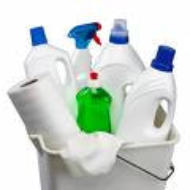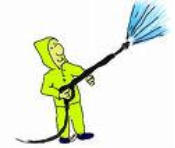












Care & Maintenance of Powder Coated Finishes
Powder Coating Provides Decorative and Protective Value to Metal Products
It is no surprise that organic finishing (powder coating) of metal products that are exposed to the weathering conditions
such as sun, rain, wind, pollution, freezing cold, salt water and a host of other conditions will degrade over time. The
elements of nature combined with other contributing factors such as stray electrical current, dissimilar metals, and
physical contact with abrasive materials may cause ware, damage, or erosion and corrosion of the coating and
underlying metal substrate and will therefore shorten the decorative and protective value of the finish. In fact it would
be surprising if coatings did not degrade over time to some degree when exposed to the direct effect of Mother Nature
in any climate or region.
Okay so we know about the detrimental effects of water, sun, and all
types of pollution when finished parts are exposed to nature no matter
how many protective layers are applied. So what can we do to prolong
the life of the finish in the field? Proper “care and maintenance” of
course! The answer may seem obvious to most but surprisingly enough
there are claims of warranty on products that are sold every day that
proclaim that the finish requires absolutely no maintenance whatsoever.
To those finishing professionals and organic chemistry experts this
unrealistic expectation sounds preposterous. Indeed it is absurd to
think that any organic coating could be 100% maintenance free and not
lose some or all of the original decorative and protective properties over
time when exposed to the effects of weather.
It is likely that you have experience at some point in your life the detrimental effects of ultra violet light (sun) exposure
on your unprotected skin (sunburn). Typically, it only takes a few minutes to a an hour for us to realize that the sun is
harmful to our skin.
It is equally likely that you have seen what the sun can do to the paint on your car or truck if the finish is not regularly
cared for and the vehicle is left unprotected for extended periods of time (chalking, erosion, corrosion). To that end, it
should be evident that proper care and maintenance is essential to prolong the service life of any surface that we value.
Water & Sun Exposure
In the outdoor environment water and ultra violet light exposure are the two factors
that are most detrimental to any coated surface. The amount exposure to ultra
violet rays from the sun is somewhat predictable at a given location. Water
exposure on the other hand may be less predictable. The frequency of
condensation from fog, humidity, and rain are natural sources of water exposure but
some coated items may be exposed to excessive water exposure for manmade
sources. Irrigation sprinklers may expose coated fences, gates, or handrail systems
to water several times per day. Lawn and poolside furniture may also be exposed to more frequent water exposure
including chlorine chemicals or salt water.
The effort to maintain the protective and decorative value of a finish is proportionate to the exposure of these and other
conditions including contact with harsh solvents or cleaning chemicals and abrasives.
Care and Maintenance of Powder Coated Surfaces
There is a great diversity of opinions about how powder coated finished products should be cleaned and maintained.
With proper maintenance, one can substantially prolong the service life of the finish on their powder coated products.
Using these care and maintenance tips can also reduce repair and replacement costs for some items.
Taking care of the powder coated finish
Powder coating in not impervious to harsh solvents and many commercial cleaning solutions will damage these finishes.
This damage accelerates staining, fading and ultimate failure of the powder coated finish. Cleaning with such chemicals
can cut the life expectancy of the finish in half. The service life of any organic finish is impossible to predict due to the
many variables that influence the coatings ability to decorate and protect. Therefore, no finishing professional would
ever attempt to definitively quantify how long a finish will last or at what rate the coating will begin to lose its decorative
or protective value, or at what rate the values are lost. We do know however, that proper cleaning and maintenance
may more than double or triple the coatings effective service life. Fabricated products that require the greatest
decorative and protective value will require some sort of proactive maintenance and care. For high visibility projects
such as architectural building applications it is wise to document and maintain records of the maintenance including the
exact cleaning procedure, materials and frequency. These records may become useful in the event the finish fails to
perform as expected.
Colors
Years ago, when the lead was taken out of gas, it was also taken out of coating. Without the
lead or other heavy metal materials in the coating formulation, previously good powder
coated colors, like blues, greens, reds, and yellows, suddenly seemed to stain and color fade
worse than usual. Today, we know that some colors react much worse than others to
chemical and pollution staining due to the interaction of the color pigments with chemicals
and minerals commonly found in commercial and residential environments. High chroma
pigment seems to be the source of the worst problems.
When choosing powder coating colors for outdoor use in high U.V. areas, keep in mind that generally speaking the
darker a color is, the hotter it gets, the more it will fade, and the quicker it will break down.
Pressure cleaning
Perhaps the most efficient method of cleaning coated surfaces such as commercial patio
furniture, bus shelters, and other outdoor products is with a pressure washer using filtered
water under low pressure. Mild detergent may be used, but do not use chlorine or harsh
cleaning solutions. It is very important that low pressure be used in pressure cleaning. If the
pressure is strong enough to move the metal surface, it may be strong enough to damage
the finish as well. Avoid using unfiltered tap water or ground water when cleaning the
powder coated finish, and pay attention to where the wind blows the water from sprinkler
systems. Unfiltered water often causes staining on outdoor products due to sulfur, iron oxide, chlorine, fluoride, and
other minerals commonly found in hard water or ground water in certain states. Only filtered water should be used to
clean and rinse powder coated products whenever possible.
Clean with mild soap and warm water
Products that have been powder coated should be cleaned with a soft brush or cloth, using mild soap and very warm
water. Soaps that have emulsifiers that break down common stains and are scum free are the best to use. The exposed
surfaces of powder coated products that are most critical should be cleaned weekly or bi-weekly for products such as
automotive roof racks, trailer or motorcycle fenders and such. Simply wipe down the top surfaces and rinse with filtered
water (not hard water). (Reference AAMA 610)
Commercial Cleaning Solutions
It is a common misconception that solvents, and other petroleum based chemicals,
are good cleaners for powder coated surfaces. Not true. These chemicals can be
very detrimental to the organic polymer based finish. They may clean well for a
time, but they clean by removing micro layers of the finish. After a while, it
becomes impossible to clean the surface using this method. Additionally, the
coating surface may become stiff and hard, and lose its barrier protective value.
Compounding this problem the coating may begin to crack and prematurely lose
gloss and fade the color. Physical aging of organic coated surfaces that are
constantly exposed to weathering conditions is an inescapable process that is
accelerated by the use of harsh chemicals.
Wax the Exposed Surface
Just as your car benefits from semi-annual applications of wax, so will the
finished surfaces of products such as outdoor furniture, outdoor lighting
fixtures, stairways, handrails, guardrails, and fences. Lightly wax the
coated surfaces with a high grade, non-abrasive car wax that contain U.V
blocker and/or U.V. inhibitors. Do not use compound waxes that contain
abrasives and be sure to wipe off any residual wax. Wax that may remain on the coated surface could
bake on in the ultra violet light from the heat of the sun and cause permanent staining.
Conclusion
From the moment the powder coating material is cured to the surface of the metal product the coating is
exposed to conditions that may be detrimental to the decorative and protective attributes of the finish.
Handling, packaging, transportation, assembly, and installation are all consideration worthy of special
attention by project planners and everyone in the supply chain.
Be mindful of the fact that there are many contributing factors that can and will affect the service life of
any organic finish. The protective value, or expected life of the finished coating is influenced in part by a
combination of all of the following conditions:
Base metal material composition, condition, and contamination
Metal preparation (pretreatment method)
Powder coating material/s selection (chemistry)
Powder coating application control methods (applied
thickness, curing, etc.)
Technical competence of the coating technicians (training)
Equipment condition (maintenance, housekeeping, calibration)
Completeness of the barrier film (encapsulation)
•
Product design details (cupping or water /moisture entrapment)
•
Open tube ends (exposed raw metal)
•
Overlapping metals (trapped moisture/raw metal exposure)
•
Coating edge coverage (thin film coverage)
•
Surface damage (scratches, assembly, installation, or freight damage)
Environmental exposure
•
Frequency of condensation (water trapping)
•
Damage in use (abrasion)
•
Chemical or mineral exposure
•
Pollution exposure
•
Ultraviolet light exposure
•
Temperature (extreme exposure and rapid variation)
•
Humidity exposure
•
Stray electrical current exposure
Field care and maintenance of the finish
•
Maintain a moisture free surface
•
Cleaning the coated surfaces regularly
•
Performing regular inspections for moisture and contamination
•
Repair and touch up of the breached areas
Following these simple rules will result in extended life for your outdoor powder coated products. Annual
maintenance costs will decrease substantially, and your products will look good for many years.
Author:
Michael W. Cravens
Presidient, IKON Powder Coating, Inc
CEO, Powder Finishing Consultants, Inc
Copyright 2010
Powder Finishing
Consultants, Inc
“Improving The Clients Condition”














